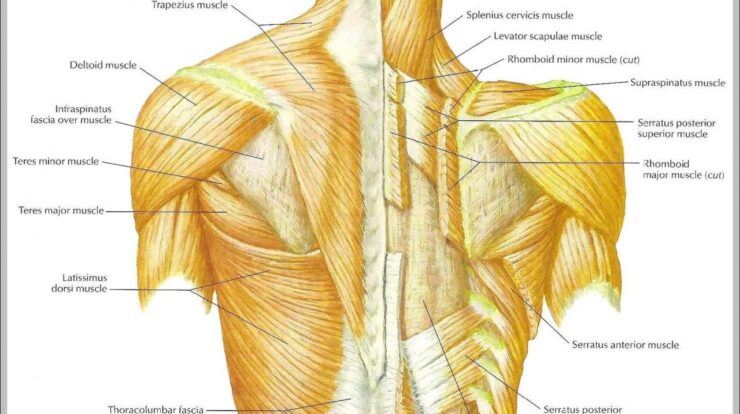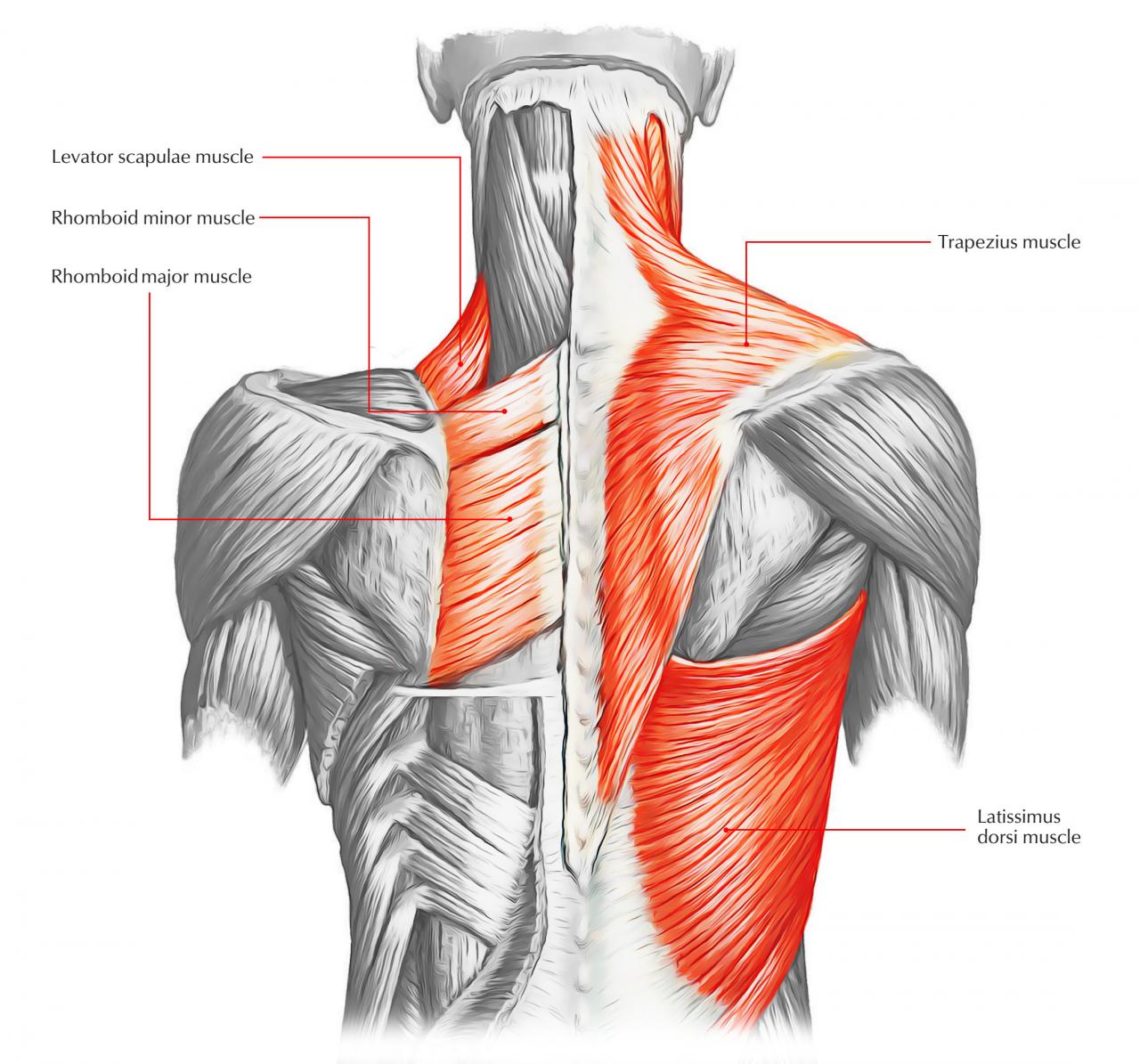
Back muscles, the foundation of strength and posture, play a crucial role in our daily lives. This comprehensive guide delves into the intricate anatomy of these muscles, providing insights into their functions and the exercises that effectively target them. From common injuries to optimal nutrition and recovery techniques, this guide equips you with the knowledge to build a strong and aesthetically pleasing back.
Back Muscle Anatomy
The back muscles are a complex group of muscles that extend from the base of the skull to the lower back. They are responsible for a wide range of movements, including bending, twisting, and rotating the torso. The major muscle groups of the back include the trapezius, latissimus dorsi, rhomboids, erector spinae, and quadratus lumborum.
Trapezius
- Origin: Base of the skull and vertebrae
- Insertion: Clavicle, acromion process of the scapula, and spine of the scapula
- Function: Elevation, retraction, and rotation of the scapula
Latissimus Dorsi
- Origin: Thoracolumbar fascia, lower six thoracic vertebrae, and iliac crest
- Insertion: Medial aspect of the humerus
- Function: Extension, adduction, and internal rotation of the humerus
Rhomboids
- Origin: Vertebrae
- Insertion: Scapula
- Function: Retraction and elevation of the scapula
Erector Spinae
- Origin: Sacrum and vertebrae
- Insertion: Vertebrae
- Function: Extension of the spine
Quadratus Lumborum
- Origin: Iliac crest and lumbar vertebrae
- Insertion: 12th rib and transverse processes of the lumbar vertebrae
- Function: Lateral flexion of the spine
Exercises for Back Muscles
Barbell Row
- Sets: 3-4
- Reps: 8-12
- Form: Grip the barbell with an overhand grip, shoulder-width apart. Bend over at the hips, keeping your back straight. Row the barbell up to your chest, squeezing your shoulder blades together at the top.
Pull-Up
- Sets: 3-4
- Reps: 8-12
- Form: Grip the pull-up bar with an overhand grip, shoulder-width apart. Pull yourself up until your chin is over the bar, squeezing your shoulder blades together at the top.
Lat Pulldown
- Sets: 3-4
- Reps: 8-12
- Form: Sit at the lat pulldown machine and grip the bar with an overhand grip, shoulder-width apart. Pull the bar down to your chest, squeezing your shoulder blades together at the bottom.
Dumbbell Row
- Sets: 3-4
- Reps: 8-12
- Form: Hold a dumbbell in each hand and bend over at the hips, keeping your back straight. Row the dumbbells up to your chest, squeezing your shoulder blades together at the top.
Superman
- Sets: 3-4
- Reps: 10-15
- Form: Lie face down on the floor with your arms and legs extended. Lift your arms and legs off the floor simultaneously, squeezing your shoulder blades together at the top.
Back Muscle Injuries: Back Muscles
Strains
Strains are the most common type of back muscle injury. They occur when a muscle is overstretched or torn. Symptoms include pain, stiffness, and swelling.
Sprains
Sprains are injuries to the ligaments that connect the bones of the spine. They occur when the ligaments are overstretched or torn. Symptoms include pain, swelling, and bruising.
Herniated Discs
Herniated discs occur when the soft, jelly-like center of a spinal disc pushes through the tough outer layer. This can cause pain, numbness, and weakness in the arms or legs.
Prevention
- Warm up before exercising.
- Use proper form when lifting weights.
- Avoid overtraining.
- Maintain a healthy weight.
- Strengthen your core muscles.
Nutrition for Back Muscle Growth

Protein
Protein is essential for muscle growth. It is recommended that you consume 1.6-2.2 grams of protein per kilogram of body weight per day.
Express your love and gratitude to the special mothers in your life with heartfelt happy mothers day wishes . Celebrate their unwavering love, strength, and sacrifices with thoughtful messages that convey your appreciation and admiration.
Carbohydrates
Carbohydrates provide energy for your muscles. It is recommended that you consume 6-10 grams of carbohydrates per kilogram of body weight per day.
Fats
Fats are essential for hormone production and cell function. It is recommended that you consume 1.2-1.7 grams of fat per kilogram of body weight per day.
Sample Meal Plan
- Breakfast: Oatmeal with berries and nuts
- Lunch: Grilled chicken salad with quinoa
- Dinner: Salmon with roasted vegetables and brown rice
- Snacks: Protein shake, fruit, yogurt
Back Muscle Recovery
Rest
Rest is essential for muscle recovery. It is recommended that you get 7-8 hours of sleep per night.
Stretching
Stretching can help to improve flexibility and range of motion. It is recommended that you stretch your back muscles regularly.
Massage
Massage can help to relieve muscle tension and pain. It is recommended that you get a massage regularly.
Sleep
Sleep is essential for muscle recovery. It is recommended that you get 7-8 hours of sleep per night.
Regular exercise is widely recognized as the cornerstone of flexibility maintenance. Engaging in regular physical activity helps preserve the range of motion in our joints, reducing the risk of developing stiffness and pain. Studies have shown that regular exercise can strengthen back muscles , improve posture, and increase overall flexibility.
Moreover, exercises specifically designed for the lower back, such as those found in exercises for lower back fat , can target areas prone to stiffness and promote greater flexibility.
Active Recovery
Active recovery is a form of exercise that is performed at a low intensity. It can help to promote muscle recovery.
If you’re looking to reduce lower back fat, consider incorporating exercises that target this specific area. Certain exercises, such as lower back fat exercises , can help strengthen and tone the muscles in your lower back, resulting in a more defined and sculpted appearance.
Back Muscle Aesthetics
Symmetry
Symmetry is important for a well-developed back. This means that the muscles on both sides of your back should be evenly developed.
Maintaining strong back muscles is essential for overall posture and mobility. Engaging in regular exercise that strengthens these muscles, such as those found in back muscle exercises , can help improve your posture, reduce back pain, and enhance your overall physical performance.
Size
Size is also important for a well-developed back. This means that your back muscles should be large and well-defined.
Regular exercise is essential for maintaining flexibility and preventing stiffness. By regularly engaging in activities that stretch and strengthen muscles, you can improve your range of motion and reduce the risk of flexibility issues. Regular exercise also helps build strong back muscles , which are crucial for supporting the spine and preventing lower back pain.
Definition
Definition is the separation between different muscle groups. This is what gives your back a sculpted look.
Back Muscle Training for Specific Sports

American Football
American football players need strong back muscles for tackling, blocking, and running.
Basketball, Back muscles
Basketball players need strong back muscles for jumping, rebounding, and shooting.
Swimming
Swimmers need strong back muscles for propelling themselves through the water.
Ultimate Conclusion
Developing strong back muscles is not merely about aesthetics; it’s about enhancing overall health and performance. By understanding the anatomy, implementing targeted exercises, and prioritizing recovery, you can unlock the full potential of your back muscles and achieve a well-rounded physique.
Question & Answer Hub
What are the major back muscle groups?
Trapezius, latissimus dorsi, rhomboids, erector spinae, and teres major.
How can I prevent back muscle injuries?
Proper form during exercises, maintaining good posture, and avoiding excessive weight.
What is the role of protein in back muscle growth?
Protein provides the building blocks for muscle repair and growth.